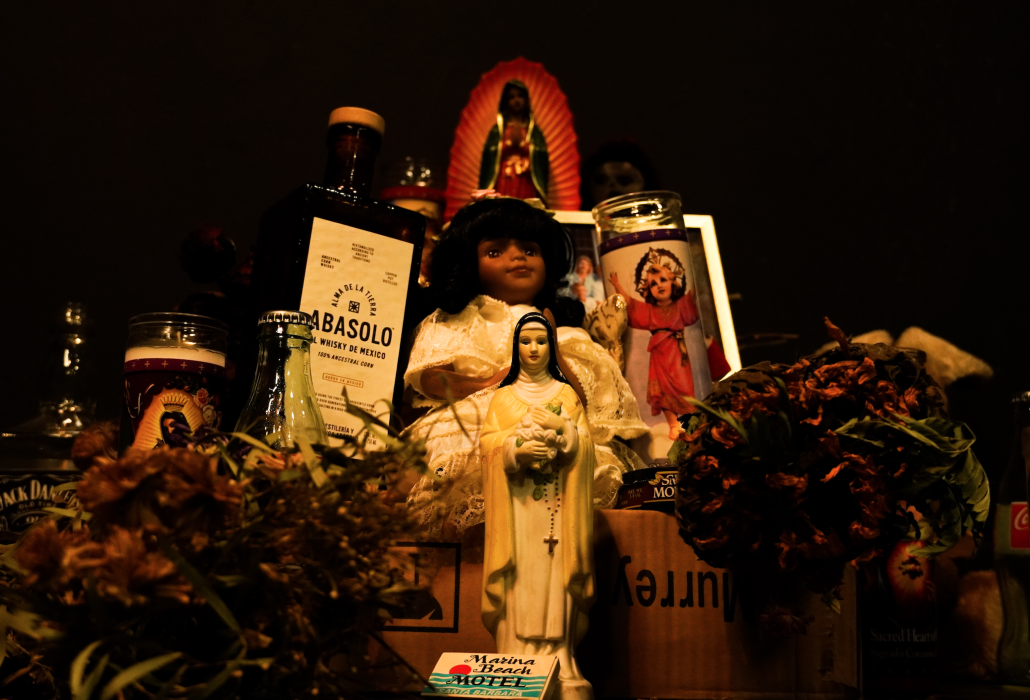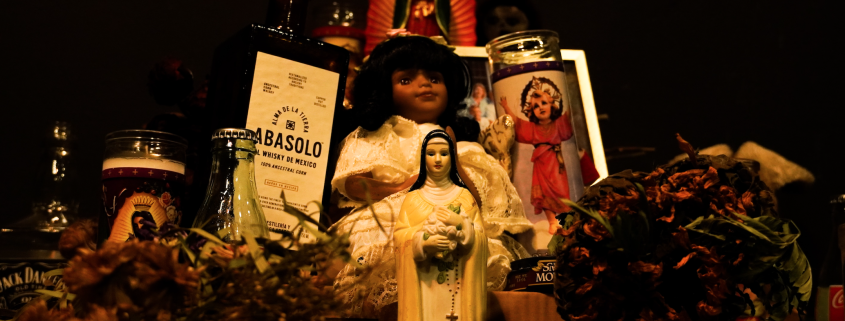Embark on a trip to ‘Virgin Creek’

This review contains spoilers.
Spring is the season for Independent Student Productions and taking magical realistic trips to places like Virgin Creek, the namesake of ART/EMIS’s latest immersive theater piece, written and directed by senior theater major Samantha Vargas.
“Virgin Creek,” tells a deeply feminine and intersectional story about the faith, love, and memories that shape one’s childhood” and follows three main characters, Mari (Mad Anderson/Sam Gajardo), Rina (MJ Jin/Mikealla Wegner), and Valeria (Sophia Lyman/Alexis Cruz), and the first two’s journey to the mystical Virgin Creek.
Audience members experience an unconventional way of viewing the piece, at least at first glance. The Massman Theater allows for standing room in the center of the theater (with the exception of seating for the elderly, pregnant women, and people with disabilities), and the entirety of the action takes place around them in a clockwise format. Despite being just a one-hour show without intermission, Vargas packs an incredible amount of content, leaving viewers to grapple with what they are watching during and after the show.
This extremely distinct and intimate roundabout method of storytelling takes inspiration from medieval pageant wagons and the mystery cycle, wherein performers at the time would go from one set to the other to tell famous religious tales for an audience. This implementation is cleverly in line with the show’s religious themes, as Catholicism drives most of the conflict throughout the plot.
ART/EMIS’ remarkable and notable fusion between art and media is heavily apparent in regards to the show’s design. Each set is distinctly different from the last, and the simple design allows actors to easily manipulate the set in any given scene to indicate change, such as the rearrangement of chairs transitioning an early scene from a coffee shop to a car on the road.
With the concept of nature playing a huge role in the overall scope of the show, sound designer Will Forker, a senior majoring in geodesign, and lighting designer Yajayra Franco, a junior majoring in lighting design, work together to time the appearance of natural phenomena, such as thunder, lightning and the sunrise, as they sporadically occur in the supposedly serene environment of Virgin Creek. The emphasis on individual visual pieces is also distributed throughout the sets, such as the attention to detail in makeshift shrines and paintings, courtesy of set designer Tania Apshankar, a junior majoring in creative writing, and artist Aasha Natsuko Dev, a sophomore majoring in cinema and media studies.
The extremely fascinating and immersive experience would not be complete without the undeniable chemistry between the three characters, which they could only achieve through the inevitable bonding throughout the rehearsal process.
“My favorite part of the rehearsal process [was] just getting closer to my cast and crew,” said Lyman, a freshman majoring in international relations. “Everyone here is so kind and warm and inviting. It’s one of the best casts I’ve ever worked with.”
The play is riddled with an uncomfortable tension between Mari and Valeria at the beginning and the growing sexual tension between Rina and Mari throughout their time together. This all comes to a head in one of the final scenes, where the audience is met with a dissonant mixture of uncomfort and sexual tension between Mari, having a previously established troubled history, and Rina, about to reveal her side of their twisted story, that keeps the audience’s jaws open from unease and overall shock — a sign of successful engagement.
“I want audiences to take away that it’s really okay to be … fragmented,” said Anderson, a junior majoring in theatre. “I love the juxtaposition of those two characters, where Mari is so obviously fragmented, and Rina just opens that up for her … When you want love, you’re deserving of love, regardless of where you’re at in your life.”
The dynamic characters of “Virgin Creek” illuminate the complicated intersection between faith and love according to Jin, a freshman majoring in Theatre. The strong storytelling and deep meaning to “Virgin Creek” allows audience members to understand this convergence.
“I’m personally connecting to these things more than I would have before because I wasn’t necessarily raised Christian,” said Jin, a freshman majoring in theatre. “I had this deeper understanding of the intersectionality, [between] femininity and queerness and Christianity. It’s really eye-opening. I’m really glad to be creating queer theatre right now … with a feminine central story to it.”
Although the story takes a more somber tone that would usually fall under the realm of queer unhappiness — a trope often seen in stories centered around queer individuals in strict religious environments — what sets “Virgin Creek” apart is the glimmer of hope offered at the very end shared between Mari and Valeria.
“Relationships take on many forms,” Lyman said. “They can be very complicated, especially to those that are in the relationship, and love, in the same aspect, takes on many forms. Sometimes it doesn’t work out, sometimes it does. But, at the end of the day, it’s love that drives us apart, but mainly drives us together.”
“Virgin Creek” opened March 23 and will run through March 27. Content warnings for the show include violence, implied death, and flashing lights.
Rating: 5/5

